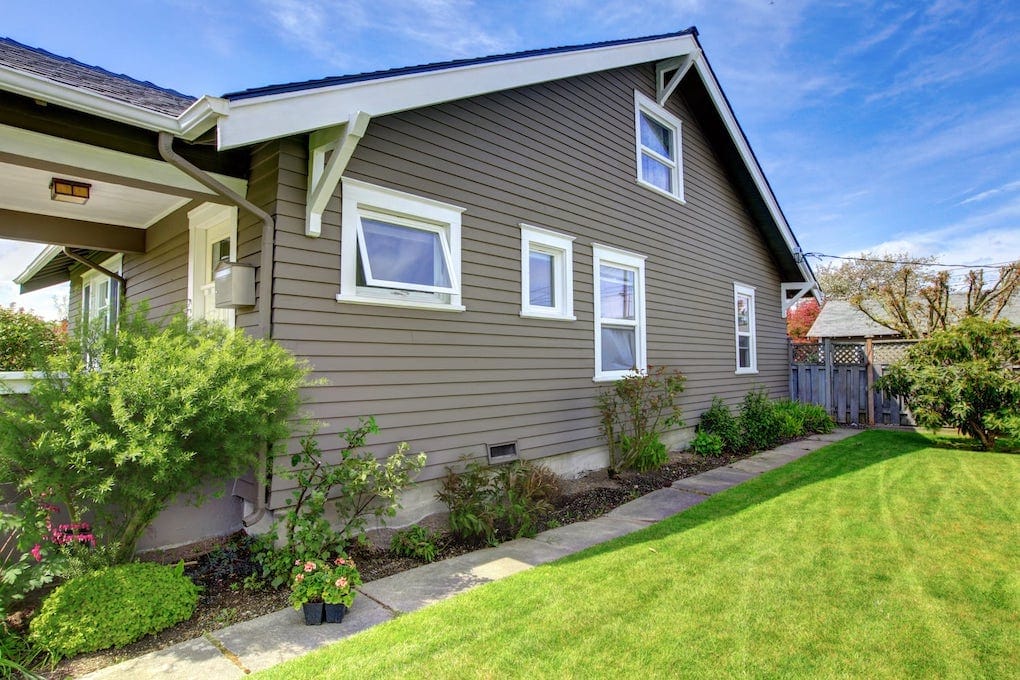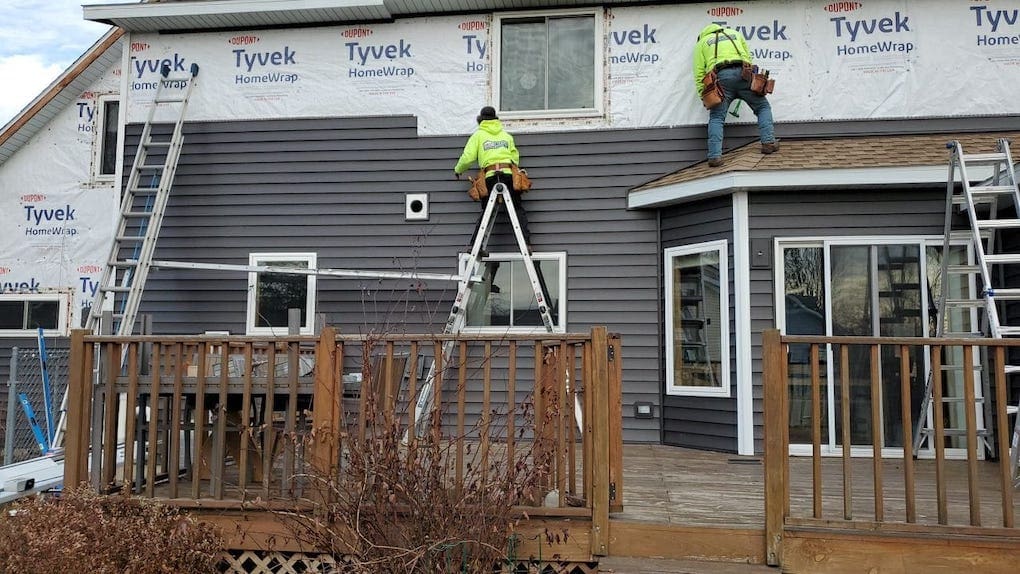The beauty of new James Hardie® siding isn’t the only reason it’s one of the top choices for homes today. The seamless James Hardie siding installation process and immense quality make it an optimal choice for homeowners (and contractors).
The undisputed resilience of fiber cement siding makes it the premium option compared to vinyl and other siding materials. Its higher cost gets homeowners more color options, a longer lifespan, and top-tier installation techniques that offer decades of protection.
Today, we’ll go through the installation process for this reliable product, and in the end, it’ll be a no-brainer to choose James Hardie for your home’s siding upgrade.
The Benefits of James Hardie Fiber Cement Siding
James Hardie is the pioneer of fiber cement siding and, since the 1980s, has grown into the world’s leading manufacturer of premium residential siding products—and for a good reason.
Fiber cement looks and feels more natural than vinyl siding and is stronger and more flame-resistant, making it a superior choice for many homes today. Benefits of James Hardie Fiber Cement siding include:
Fire Resistance:
James Hardie fiber cement siding has been tested in accordance with ASTM E84, E119, and E136, which heeded the following results:
- James Hardie fiber cement is non-combustible
- Approved for fire-resistant rated construction (ok to use near fireplaces/fire pits)
- It has a flame spread index of 0
- & a smoke development index of under 5
This means that your home will be better protected against fire damage. While fiber cement isn’t fireproof material, it is highly resistant to fire and can slow the spread so you and your family can get to safety with minimal exterior damage.
Weather Resistance:
James Hardie fiber cement is made to withstand any weather condition Mother Nature throws its way. James Hardie fiber cement doesn’t back down from hurricanes and hailstorms to blizzards and heavy rain. In particular, Hardie fiber cement siding resists the impact of hail and windblown debris and can withstand the most extreme cold and heat.
Highly Durable—Made to Last
Your James Hardie fiber cement siding will likely last long after its 30-year warranty. When properly installed and maintained, it can last up to 50 years, even in the harshest climates.
Many Color Options
Hardie fiber cement has at least 23 factory colors available, plus more in trim, plank, and other styles they offer. Homeowners can choose from their Statement Collection, Primed Collection, or Dream Collection, which offers over 700 custom color options.
Great Warranties
Most James Hardie products have a 30-year (transferrable) Express Limited Product Warranty, more than many other manufacturers. More specific warranties may vary depending on the product, and you can find more information here.
Significant ROI and Boost’s Your Home’s Value
Investing in your home is one of the best ways to increase its value and boost curb appeal. James Hardie siding is more affordable than many home renovations, which can give you great ROI, especially if you’re trying to sell your home down the line. And the transferrable warranty is an added benefit.
Easy Maintenance
Maintaining your home’s exterior is vital to keeping its integrity and preventing voided warranties. Issues caused by lack of maintenance or cleaning may not be covered under warranty. Maintenance of your siding includes:
- Bi-annual or annual rinsing of your siding using a basic garden hose. Avoid pressure washers as those can damage your siding and other parts of your exterior.
- A low-pressure water spray or washing with a soft bristle brush and mild detergent (soap and water) for more stubborn cleaning jobs.
- Click here for more maintenance tips direct from James Hardie.
The installation of James Hardie fiber cement is pretty simple but requires some level of expertise and the following tools and steps to get the job done right. Installing James Hardie Siding is something you’ll reap the benefits of for decades to come.
Materials and Tools Needed to Install New Siding
The video above shows which materials and tools you’ll need to properly install your new James Hardie siding. This list includes the following items:
- 16-gauge finish nail gun (for your trim)
- Circular saw (with dust collection system if able)
- Pencil
- Pneumatic siding nail gun
- PPE Equipment (hard hat, gloves, goggles, dust mask)
- Tape measure or laser tool
- Workbench
A workbench will allow you to cut the pieces easily on a sturdy surface. Note: you could also use a miter saw to trim your pieces if you don’t have a circular saw. For easy clean-up and to avoid breathing in dust, attach the saw to a dust collector.
Step-by-Step Installation of James Hardie Siding
Now the fun part: installing new beautiful James Hardie siding. Installing this premium product doesn’t take much additional effort or steps to install as other types, but it is vital to follow these steps for a smooth process.
Step 1: Prep Work
Before installing your new James Hardie siding, it’s essential to do some prep work. This includes removing any old siding, caulking and flashing around windows and doors, and trimming the sheathing as needed.
If you’re replacing existing siding with Hardie fiber cement, remove any nails or staples before moving forward.
- Once you have a clean slate, begin carefully installing your foam, plywood, or strand board.
- Next, you’ll cover the sheathing with house wrap, marking stud locations with chalk.
Step 2: Measure and Cut Your Siding
Now it’s time to cut your James Hardie siding. After clearly measuring and marking where and how you’ll place your new siding panels, you can begin pre-cutting your materials.
The easiest way to do this is with a circular saw or miter saw. If using a power tool, always use caution and wear appropriate safety gear. Cutting your siding beforehand can make the job go super fast.
Step 3: Install Necessary Flashing
Flashing for siding needs to go above windows, baseboards, or any other time siding will be installed above something that isn’t the bottom of your house. Be sure to leave 6 inches of clearance on the bottom of your siding and 1/4 inch of clearance above any flashing and at the edges of any trim.
Step 4: Install Your Siding
Hardie Board® can be installed by fastening it directly to the house, without any tracks or other fasteners. Line up your starter strip on the very bottom of your house with that 6-inch clearance. Since your bottom-most siding panel cannot overlap one below it, the starter strip ensures your bottom siding panel is angled appropriately like the rest.
To install the James Hardie siding, use your pneumatic nail gun to carefully and quickly nail the panels into place. Nails should be placed every 6-10 inches and at the top of the panel so that the nails are covered by the overlapping panel.
Working your way up, be sure to stagger the joints between each panel for a more professional look. Also, at the end piece of each panel, place your small sheet of flashing that will seal every seam between your siding panels. This is vital to create a watertight seal. The video below is an excellent walk-through of the entire James Hardie installation process.
Step 5: Install the Trim
The trim will go one after all the panels are in place. That 1/4 inch space between the end of your wall and your panel is essential. The trim will fill this small gap, which will then be sealed with caulk and painted over if necessary.
Step 6: Seal With Caulk
Yes, all James Hardie siding is sealed with caulk. This ensures everything is watertight and keeps your siding flush against the edges of the trim. You can use a James Hardie Touch-Up Kit to match any colors at the edges where you use caulk.
Step 7: Clean Up
Do one final check of the edges, fasteners, trim, and all aspects of your new siding to ensure it’s installed correctly. Clean up any loose nails with a magnetic roller, and there you go—you’ve just installed James Hardie siding with ease!
When to Call the Pros
While homeowners can technically handle this installation, we always recommend hiring a professional installer. For one, this is a 2+ person job that comes standard when you hire the pros. And second, they have the expertise and precision needed to properly install siding, so you don’t face issues with leaks or damage sooner than later.
Hiring a reputable siding specialist like First American Roofing and Siding is vital to the longevity and beauty of your new siding project. We know James Hardie products like the back of our hand—so let us handle the grunt work. We will hand-select a custom solution just for you, so contact us today to get a quote on your new siding project.









